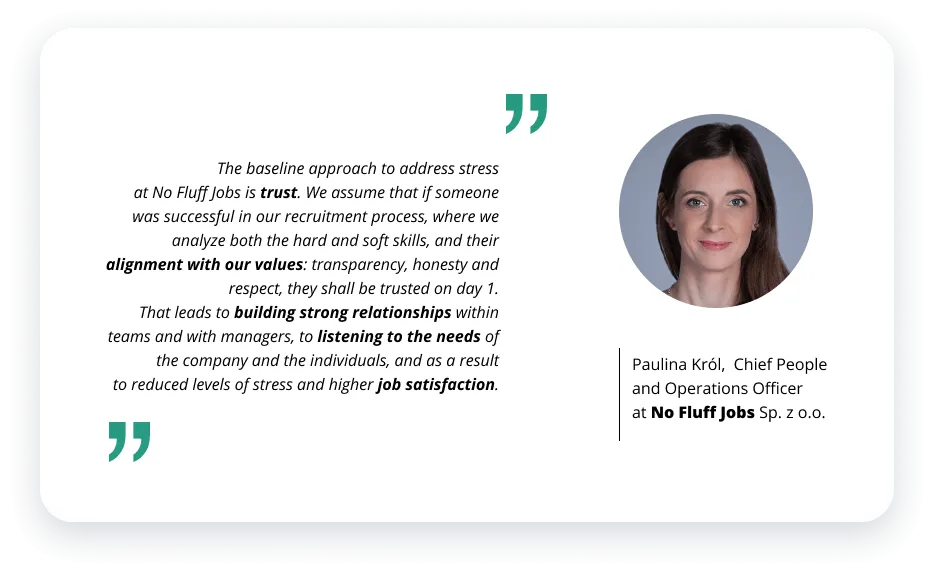Stress at work: ace stress management in the workplace


Up to 35% of employees report high levels of stress at work. When mismanaged, workplace stress can hamper productivity, cause sick leaves, and slowly suffocate the organization. That’s why a conscious approach in dealing with it is crucial.
Stress is basically the organism’s reaction to the unusual, threatening, or suspicious situation. Stress is both an emotional and physiological reaction. With the adrenaline boost encouraging the “fight or flight” reaction, stress used to be and still is one of the key survival mechanisms.
Stress is also a natural part of life, with people being exposed to hundreds of stressors a week, sometimes a day. An aggressive driver, an unknown, loudly barking dog, or harsh words from a colleague are typical stressors one encounters.
Pikes of the stress levels are natural. If the high-stress levels are maintained for a longer time, sometimes for weeks and months. This situation is also not uncommon, with people facing harsh challenges in their lives. Or working in a stressful environment.
This text covers:
- Statistics about stress at work
- Common sources of workplace stress
- Ways to manage the stress at work and what the HR departments can do to help
Stress at work stats
According to the American Institute of Stress, 83% of the US workforce says that work is a major stress source in their lives. Furthermore, 76% of workers say that high-stress levels are affecting their personal relationships.
Stress-related diseases are hurting employees and companies alike. More than 50% of workers are not engaged in their work due to the high levels of stress. This results in higher costs, with companies spending up to 75% of workers's salaries to cover the loss in productivity or find a replacement for the employee who resigned. It is estimated that up to 5 working hours a week are lost due to the employees thinking about their stressors.
This makes stress in a workplace a matter of high interest to the HR departments. The human resources specialists are responsible for both reducing the cost of skill acquisition and ensuring access to the skilled professional.
Discover more workplace stress statistics here.
Common sources of stress at work
Stress at work can be an integral part of it and sometimes cannot be separated or reduced easily. Think about paramedics working during traffic accidents, surgeons, or traders who can either earn or lose millions every minute. Or teachers, responsible for both the safety and education of a whole class of diverse children, having different needs and requirements.
According to “The Workplace Health Report,” up to 35% of employees report negative levels of stress at work. What exactly can be stressful at work? In the report, the employees surveyed have named:
- Overwhelming and workload – 76%
- Lack of control – 35%
- Lack of support – 26%
- Senior staff – 25%
- Peers – 18%
- Insufficient training – 16%
- Job security – 13%
- Working from home – 11%
On the other hand, though, over 76% of employees surveyed point out that they experience significant stressors outside of work as well. Considering that, limiting the stress at work can be considered a holistic approach toward wellbeing – especially since the employer has a real and meaningful impact on the stress levels at work. The HR professionals are the first line of defense against the negative levels of stress.
Ways to manage stress at work
There are multiple stressors at work, with some of them being easier to reduce or totally unrelated to the nature of the work itself. Toxic coworkers or bad-tempered bosses are good examples of these.
There are multiple ways to spot the reasons behind the stress at work and tackle it in a way that limits the possible sources to reduce.
Track stressors
Knowing the source of the stress is the first step toward managing it properly. Running a journal of stressors, with the situation, the feelings, and the thoughts regarding the source of stress, is both increasing the self-awareness and the form of the therapy.
According to the research published by Cambridge University Press, there are multiple mental benefits of writing about the experiences, including hard and even traumatic ones. In the control group, people writing about their traumatic experiences have shown significantly better emotional and behavioral outcomes than people who have written about neutral experiences.
Journaling is both a great way to find the greatest stressors and deliver a first-line mental defense against the odds. According to the article mentioned above, it is not required to start big – no more than 15 minutes a day is sufficient to bring all the benefits.
What the HR department can do:
The HR team’s response related to journaling can take the form of regular feedback sessions and employee well-being evaluation talks or surveys. While it is far from the therapeutic advantages of regular journaling, naming and describing the emotions can bring significant improvements. The key is building the atmosphere of trust and safety to let the employee name his or her real feelings.
Develop healthy responses
High levels of stress tend to result in building automatic, usually unhealthy responses like alcohol abuse or overeating. While giving a short relief, these responses hurt the health and well-being in the long term. To cope with the stress at work, one needs to find good, healthy, and reliable responses, like sports, mindfulness, meditation, or anything else – as long as it is not hurtful for either the employee or the surroundings.
What the HR department can do:
Developing healthy responses like sport or mental well-being is a perfect aim for strategy. The employer can participate in sports programs or provide the employees with mindfulness training during work hours.
There are also more sophisticated benefits, like providing the employees with mental, psychological, or psychiatric support as a benefit. Having a particular goal like aiding the workforce with building healthy stress responses can be a game changer when it comes to the company’s benefit strategy.
According to studies, digital interventions in the workplace are effective in reducing occupational stress and improving employee well-being [Source: karger.com, March 2023, Effectiveness of Digital Interventions in Reducing Occupational Stress].
Take stress off your HR team’s shoulders. Automate time tracking and leave management with Calamari so your HR professionals can focus on employee well-being instead of admin stress. Start your free trial now!

Staying organized
Imposing a structure and order on one’s day can be a great way to reduce the level of daily stress. Depending on the type of job to be delivered, there can be multiple ways to impose order in work, with using Kanban tables, to-do lists, and charts being only the top-of-mind.
Being organized and tracking the progress done in work can:
- Reduce stress
- Improve sleep
- Increase focus
- Boost productivity
- Reduce depression and anxiety
According to simplyproductive.com, up to 27% of employees feel disorganized at work, with 91% saying that they would be more efficient if their work was better organized. Considering that, the lack of organization is the endless loop, with stress causing reduced productivity and ineffectiveness inducing stress.
A side effect of being better organized is having a clear record of work done and having better arguments when speaking with superiors regarding the progress or updates.
Being organized also applies to avoiding multitasking. While seeming different, multitasking is one of the most vicious and deadly killers of productivity. It increases stress levels, with the feeling of being overwhelmed and having no job done.
While common and sometimes praised as a “new way of working,” multitasking comes with great cost for no gain. From the psychological and business perspective, batching (stuffing all similar activities in one row or timeframe) is significantly more effective, enabling one to deliver more effects and keep the stress at bay.
What the HR department can do:
Self-management is a skill, like any other skill. It can be self-taught or trained, and providing the self-management training sessions as a benefit or a part of a company culture is a perfect tool for the HR department to build the culture of being organized. It can be a part of an onboarding process, paired with the introduction to the tech stack and procedures in the company.
Don’t forget about ergonomics
Stress is increased in uncomfortable settings. While some positions allow only limited ways to increase the working comfort, others can be made less stressful with minimal effort.
One can use noise-canceling headphones (or earplugs in a budget version) to reduce the background noise. Depending on the type of work, one can request a better chair or a higher desk. Considering the day-to-day impact of minor stressors, having only a slightly more comfortable working environment can bring great improvements.
According to MedicalNewsToday, long-term exposure to noise pollution (common in office environments) increases one’s sensitivity to other stressors. Considering that, getting more comfortable at work, especially by building a more noise-prone environment, can be a great way to reduce the overall working stress.
What the HR department can do:
During the pandemic time it was common to borrow a computer or a screen from the company – so why not a comfortable armchair? This is only a matter of goodwill and identification of the employee needs – a perfect task for the HR department.
Moreover, the HR team can perform surveys regarding the employee satisfaction with the chairs or desks they are using. Having information that there is some shared or common pain regarding the working comfort can bring an easy win.
Find support
Coping with high levels of stress is a tremendous task that can be too difficult to be handled alone. Accepting help from others can be crucial in managing the high levels of stress in daily life.
Depending on the stress levels and the severity of the situation, the support from friends or family members can be enough. If not, one may require support from a skilled psychologist or therapist. Some companies have dedicated benefits or teams that help employees of all levels in coping with stress and support them in finding their way to balance.
What the HR department can do:
Finding support is all about the culture of the company. If the organization uses the rhetoric of fear and distrust, sharing the pain with basically anyone can be a high risk or considered weakness. Yet if there is an open, diverse culture of mutual trust and support, finding the support comes much easier. Yet, it is hard work for months, if not years, if the open and friendly culture is not rooted in the organization.

Establish boundaries
The modern culture of working in a hybrid or remote model builds the unspoken requirement of being available 24/7 and working all around the clock. This can get hurtful with increasing stress and causing burnout. According to the data gathered by Apollo Technical, up to 65% of home-based employees actually work more than they used to before going remote.
Boundaries to be established can be either physical or mental.
- Physical boundaries – In the perfect world, one would have their own home office, with a fitting desk, comfortable armchair, and a fancy whiteboard full of colorful Post-its. But the harsh reality is far from that, with employees living in overcrowded apartments with their families. Having a quiet corner with a curtain or at least a desk that is used for work only is the perfect way to set this type of boundary. With that, all the breaks during work can provide an opportunity to plug out from work by simply leaving the computer.
- Mental boundaries – These are harder to establish and require some self-discipline. These include plugging off from work after hours, not responding to emails after hours, and making all the choices that build the work-life balance.
According to studies, remote-work arrangements can reduce psychological and physical stress responses when moderated by appropriate job demands and social support, though fully remote models may carry increased presenteeism risks [Source: frontiersin.org, July 2021, “Remote Work Decreases Psychological and Physical Stress Responses”]
What the HR department can do:
The HR team can take on the uneasy role of a balance sentinel, being a point of contact when employees’ boundaries are disrespected or the team leader feels that there is an issue with productivity or contact with the employee.
Avoid conflict
Conflict is one of the most destructive forces in the working environment. Work is one of the major elements of life, consuming plenty of hours, usually with an enclosed group of people. Thus, with the conflict in the team, avoiding the stressor can be extremely complicated, if not impossible.
According to the CIPD report, 26% of employees and 20% of employers say that the conflict is prominent in their workplace. When not managed properly, conflict can result in bullying or mobbing in the workplace. This bears serious psychological consequences, as well as a high risk of further consequences, from legal to image ones.
As an employee, it is reasonable to avoid aggressive and toxic coworkers. Furthermore, one can resign from participating in the conversations about sensitive topics, like religion or politics.
One should also get to know about anti-mobbing and anti-discrimination procedures in the company and keep awareness regarding the rights and responsibilities.
What the HR department can do:
Managing conflicts in the team is an essential HR responsibility. Avoiding conflict goes deep to the organization's structure and culture. Building a conflict-prone working environment is an art in itself and can look vastly different in multiple companies or organizations.
Take time off
Taking regular time off is vital to keep the stress levels in control. It is also not as popular as one would imagine. According to Worktest data, an average private-sector employee has taken seven days of paid time off in a year. According to the data gathered by Zippia, up to 55% of Americans don’t fully use their paid time off. Actually, Americans failed to use 768 million paid days in 2018.
Taking the time off is a great way to recharge and rest, assuming the boundaries are set and one is really out of work.
What the HR department can do:
The HR team can actively encourage the team to take time off by reminding them about the option or promoting the culture of avoiding overwork. The internal communication can show the executives and employees setting a good example.
Building the culture of time off requires implementing a sophisticated yet reliable leave management system that stores and processes the information. Without the clear information about the time off the employees can take regarding their contract, benefits, or other variables, encouraging them to do so can be counterproductive.
Learn how to relax and find time to do it
Apart from taking a long time off, one also needs to practice some form of day-to-day relaxation to keep stress levels at bay. There are numerous ways to find yourself in a relaxed mood – from running to mindfulness and meditation to yoga and relaxation techniques.
There are multiple manuals and guides online about finding the inner balance. Free courses and instructions on YouTube, paid courses, or any hybrid form. Meditation is one of the simplest and most popular ways to reduce stress daily. According to the data gathered by disturbmenot.co, over 14% of Americans have meditated at least once, and it is estimated that between 200,000 and 500,000 people are meditating worldwide. It is implied that meditation can reduce the risk of being hospitalized for coronary disease by 87% and can boost productivity by up to 120%.
What the HR department can do:
Again, it is a great opportunity to reshape and rethink the employee benefits policy. Providing the employee with skill-building sessions and training can be considered a great benefit and the way to keep the employee loyal to the company.

Final thoughts
Stress at work is a natural element of life. On the other hand, when the greatest sources of stress are not the part of the work itself but come from the toxic environment and the levels are reaching harmful or dangerous levels, reaction is necessary.
HR departments have a plethora of tools and ways to manage the workplace stress and mitigate the risk of making it unbearable. On the other hand, stress is a challenge creeping behind that is easy to overlook in the dynamic world of today’s workplace. This makes proper tools and education even more important.
Stay inspired with Calamari’s HR insights: join our Newsletter for expert advice on employee well-being, stress prevention, and productivity.

FAQ – Stress at work: ace stress management in the workplace
1. What is the main cause of stress in the workplace?
The biggest sources of stress in many companies are excessive workload, unrealistic deadlines, and poor communication. Recognizing these workplace stressors is the first step to reducing stress and improving employee well-being.
2. How does work-related stress affect employees’ health?
High stress levels increase risks of sleep disturbances, mental health challenges, and physical fatigue. Chronic work-related stress also contributes to burnout and reduces overall productivity at work.
3. What are effective stress management techniques in the workplace?
Practical techniques include mindfulness, breathing exercises, and setting realistic goals. These stress management tips help workers cope with stress and regain focus in a busy work environment.
4. How can HR reduce stress at work effectively?
HR professionals can implement flexible scheduling, encourage breaks, and promote employee assistance programs. Such prevention strategies directly help to reduce the effects of stress and improve employee health.
5. What role does the workload play in increasing work-related stress?
Unrealistic workloads are one of the top causes of stress and can lead to exhaustion or turnover. Balancing work demands and encouraging time management can prevent unnecessary stress at work.
6. How does stress management contribute to better workplace culture?
A company that actively supports stress reduction builds a positive workplace culture focused on employee well-being. When workers cope with daily stress better, morale rises, and overall health and safety improve.
7. What are some ways to manage stress before it becomes harmful?
Setting boundaries, improving work scheduling, and taking regular breaks are simple ways to reduce stress. These actions give employees a sense of control and improved health outcomes over time.
8. How does the NHS define or address stress at work?
The NHS classifies stress in the workplace as a serious health and safety concern that requires preventive measures. It encourages organizations to ensure that employees share their feelings early to reduce the potential for chronic stress.
9. What’s the connection between stress and mental health?
Research from the American Psychological Association links stress and mental health directly, showing that chronic work stress leads to anxiety and depression. Early support and mental health resources can prevent escalation.
10. How can companies preventing stress create a healthier work environment?
Employers can fight stress by addressing potential stressors, offering mental health support, and creating employee assistance programs. A culture focused on health and well-being reduces sick days and strengthens engagement.

















